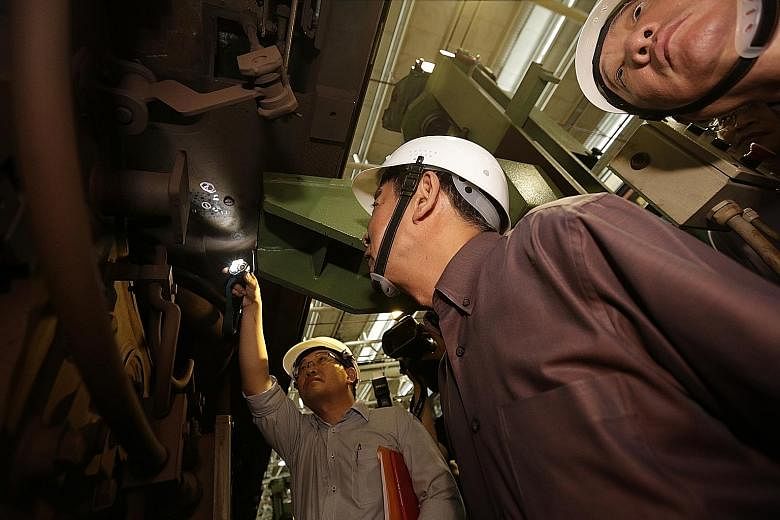The hairline cracks found on the 26 China-assembled trains did not pose a safety risk, so the issue was not made public when the defects were discovered three years ago, said Transport Minister Khaw Boon Wan yesterday.
While the defects required the trains to be sent back progressively to the manufacturer in Qingdao to have their car bodies replaced, this also did not impact the capacity of the North-South East-West Lines (NSEWL), he said.
"These two issues, which will have impact on Singaporeans and commuters, are not being compromised at all," he said, explaining why the Land Transport Authority (LTA) and the Ministry of Transport (MOT) treated the rectification process as a "routine matter".
Yesterday, a press briefing was held at SMRT's Bishan depot for, in Mr Khaw's own words, a "full airing of the issue" and to correct any misinformation.
The defective trains were brought to light by Hong Kong online news portal FactWire only last week, raising questions about why the issue was not made public before.
To date, five of the 26 trains - bought from Kawasaki-Sifang, a Japanese-Chinese consortium - have been rectified, and another one is currently in China undergoing rectification.
The hairline cracks were discovered during routine inspections in July 2013, after the trains had been in service for more than two years. The cracks were found on the surface of the car-body bolster - an aluminium alloy structure under the train carriage.
Mr Khaw asked: "If you were to go public on something that is not major, would you (not) unduly, unnecessarily cause a panic among the people?
"With hindsight, the lesson to be learnt is (that) a seemingly routine matter, in mischievous hands, can be mis-spun into a controversy."
Mr Khaw added that it is easy now to question the LTA's and MOT's decisions. "When you are on the spot at the time... you have to weigh the downside of coming up with much ado about nothing, when it is not a serious matter... I can understand why LTA and MOT did what they did at that point."
While the trains - each requiring around four months to be rectified - are being sent back to China one at a time, this has not affected the LTA's plans to inject more trains and boost capacity on the NSEWL, Mr Khaw said.
This is because there is a "buffer" of trains, he said - meaning that 124 of the 140 trains currently available on the network are sufficient to meet the commuter demand.
A similar buffer will be kept up until 2019, even as more trains are added and when the LTA expects all the 26 defective ones to have been rectified.
From next year, two trains will be sent back each time, instead of one.
Based on investigations, the cracks developed because of a defect in the manufacturing process resulting in impurities being introduced in the aluminium material.


